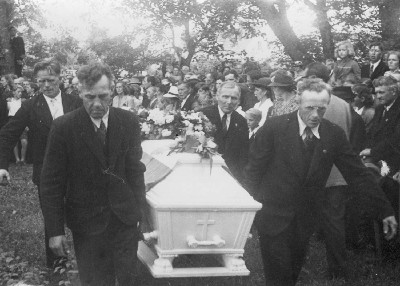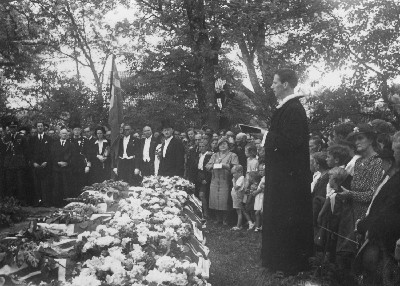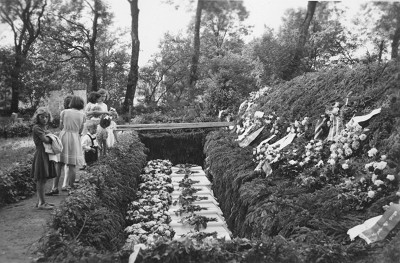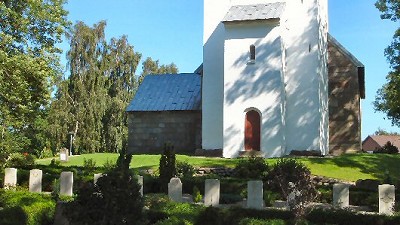PILOTS: Part III
(Last updated: 25.02.13 - Nicodeme Guilonard)
Here's the third list of WWII 206 Squadron Pilots, click on their photographs for their story...

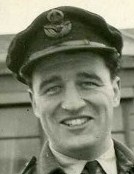
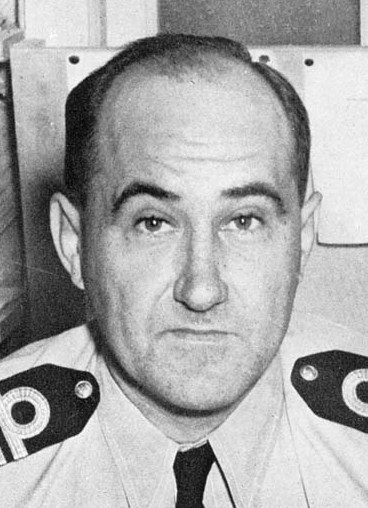
Richard Patrick (S/Ldr) DFC AFC by John Ferguson (May 2010) Flew with Ken
William Roxburgh (F/Lt) DFC by Richard Thomas (May 2010)
[No Pic] Anthony Frederick George by Richard Corckett (Feb 2011)
Nicodeme Guilonard by Niels Norgaard Nielsen (Apr 2011
Richard C Patrick
Rank: Wing Commander
Number: 41457
Joined 206: ??/08/1939
Flew with Ken: 4 times
Born: 08/10/1917
Died: 28/03/2005
I was contacted by a WWII medal researcher; John Ferguson in October 2009 who had recently obtained an impressive medal set of a Coastal Command Pilot. That pilot happened to be Richard 'Butch' Patrick from 206 Squadron during WWII.
Richard 'Butch' Patrick
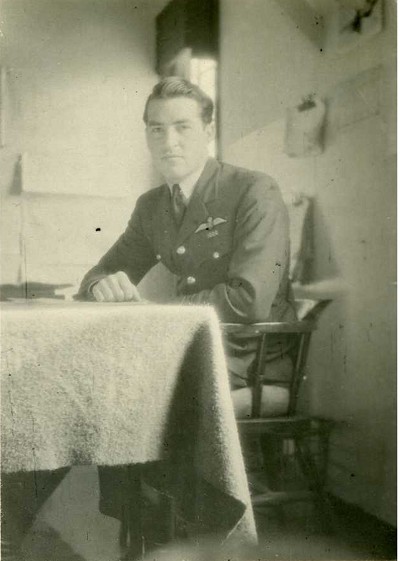
I knew the name straight away as I had the above photograph of him within the 'F/Lt Ken Bass' section within 'Crews'. This photograph was originally provided by Simon Nelson whose fathers Memoir, Lawrence Nelson, is within 'Pilots: Part I'. Richard Patrick is recorded flying with Ken on 4 occasions and signed his logbook several times.
Richard joined 206 Squadron in 1939 and was involved in the 1st recorded operation of the Squadron in Anson K6193 'Y'.
National Archive Record: 3rd September 1939
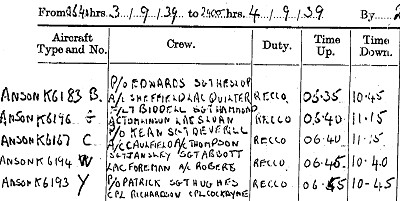
In May 2010 John Ferguson kindly provided the following medal photographs and information he had captured to date...
DFC - AFC - 1939-45 Star - Atlantic Star - Italy Star - Defence Medal - War Medal 1939-45
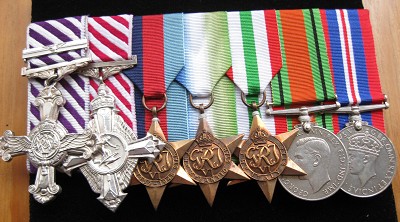
Distinguished Flying Cross
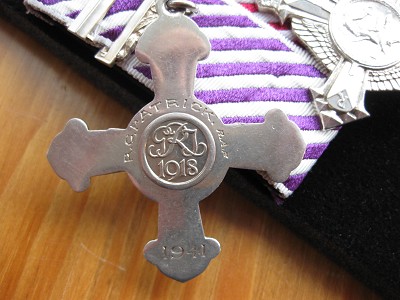
Wing Commander Richard Cecil (Butch) Patrick DFC, AFC
By John Ferguson, May 2010
Gallantry awards connected with the high profile activities of Fighter and Bomber command and are quickly snapped up even at the very high prices they can command so when a DFC medal group to Wing Commander R C Patrick, who served with Coastal Command, appeared on a dealers list at a reasonable price I quickly bought them. This led to a research project that has led me from Essex to Dorset and onto Western Canada to trace the career of a brave and dedicated pilot.
Richard Patrick was born in Thornhill, Ontario, Canada in 1917 and first appeared on "the plot" when he joined RAF in 1938 and was appointed Acting Pilot Officer on Probation. He joined 206 Squadron in August 1939 and was confirmed as Flying Officer in September of the same year. In April 1942 Richard had risen to be Commanding Officer of the Squadron. Records show that during this period he had carried out many operational flying hours including an attack on a U Boat on 20th September 1939 whilst flying in an Anson and many shipping strikes after conversion to Hudsons. Richard Patrick served with 206 Squadron until 19th February 1944 when his Flying Log records his last flight as - A/S Patrol - Lagens Azores to Ste Eval returning to UK after operational tour with the Sq.
Whilst with 206 Squadron Butch Patrick was awarded the Distinguished Flying Cross (DFC). Public Record Office Air 2/9251 has recommendation drafted 13th July 1941. This reads as follows -
"Flying Officer R.C. Patrick has been a member of No.206 Squadron since August 1939, and has at all times set a high example of flying and devotion to duty. His qualities of endurance are exceptional, having completed 900 hours operational flying without showing any signs of strain. His willingness to seek and engage the enemy has always been an inspiration to the less experienced pilots of the unit.
"The outstanding attacks which have been carried out by him against ground targets are:
"(a) Two attacks on enemy dockyards in July 1940, when direct hits were registered in spite of accurate and intense anti-aircraft fire.
"(b) A daring attack on De Kooy aerodrome, when he released his bombs at 400 feet scoring direct hits on aerodrome buildings.
"Flying Officer Patrick has recently been employed on special long range operations in Hudson aircraft. These he has carried out most zealously and with the greatest accuracy."
To the above, the Air Officer Commanding, No.19 Group, adds:
"This officer was detailed for operation "Hooligan", and on one occasion having reached his destination and preparing to land, he was signaled not to pursue the operation further and so returned to base."
Clearly a brave and committed pilot because in May 1942 he was awarded a bar to his DFC. The citation in the London Gazette is very brief but again the citation draft made impressive reading -
"Squadron Leader Patrick, who has completed a second tour of operational duty, has been in command of his squadron since April 1942. During that period he has taken part in four attacks on U-Boats and has displayed flying ability of a high order. By his keenness and skill, he has set an inspiring example to the other members of his squadron."
In his flying Log he records one submarine going down and bubbles coming up like Epsom Salts!
From 206 Squadron he was transferred to 231 Squadron Transport Command and details of his service with this squadron are still being researched. What is known, is that Butch Patrick undertook the development of "The Pacific Service" flying from a base at San Diego in the USA in the role of Senior Captain of the route in which he was responsible for carrying out flying route checks with the Junior Captains.
Whilst with 231 Squadron he certainly kept up very high standards of flying and on 7th September 1945 he was awarded the Air Force Cross (AFC).
The citation was drafted when he had flown 3,500 hours, 1,699 on current duties, 540 in previous six months reads -
"This officer is an excellent pilot and captain of aircraft and has proved himself to be an enthusiastic worker. Since the inauguration of the Pacific Service this officer has been based at San Diego and as the Senior Captain on the route, has performed all the route checks of the junior captains."
Records and awards clearly show that Butch Patricks career with the RAF was long and distinguished. Rising from Pilot Officer in 1939, Flying Officer 1940, Flight Lieutenant 1942 to Squadron Leader 1944. In July of 1946 he was granted a permanent commission and went on to become Wing Commander in 1955 finally retiring in October 1955 after seventeen years of distinguished service and well over 3500 hours of operational flying.
Butch Patrick did not just hang up his wings after his RAF career, he went on to found a very successful company involved in the supply of aircraft engineering components becoming very well known in that industry.
Sadly Wing Commander Butch Patrick passed away at Colchester on 28th March 2005. Thanks to the discovery of his medals, a record of service and that of 206 Squadron will go forward for as long as medals are collected.
I am greatly indebted to Robert Stitt ASct of Cowichan Bay, British Columbia, Canada for his providing a great deal of information, photographs and leads. This has been made possible as Robert is publishing a book - Boeing B-17 Fortress in RAF Coastal Command which I understand includes information on Butch Patrick and 206 Squadron. See the 'Useful Information' section for details.
Also my thanks to Ted Nelson who had flown with Butch Patrick and wrote to provide me with a copy of his flying log detailing the flights.
Last but not least thanks to John Lowe for his interest in my research and for spreading the word.
Links to Ken
I checked through Ken's logbook and found that he flew with Richard Patrick on 4 occasions, Ken was the 1st Pilot on one of those. The dates were as follows...
-
9th September 1942: Fortress IIA FK184 'K' - Night Flying
-
11th September 1942: Fortress IIA FK184 'K' - Night Flying. Ken was 1st Pilot
-
7th January 1943: Fortress I AN520 'X' - To Silloth (see below)
-
7th January 1943: Fortress I AN520 'X' - Silloth to Hawarden (see below)

At this time Richard was a Squadron Leader and he signed of Ken's monthly summaries for October 1942 through to February 1943. Here is the summary for December 1942:

Here's a great photograph of Richard Patrick provided by Robert Stitt which shows the first Fortress IIA after it arrived in 206 Squadron which would have been in August 1942.
Fortress IIA FL451 'D'
F/O William Roxburgh - F/O Tom Pearse - F/O Freddie Wills - S/Ldr Richard Patrick
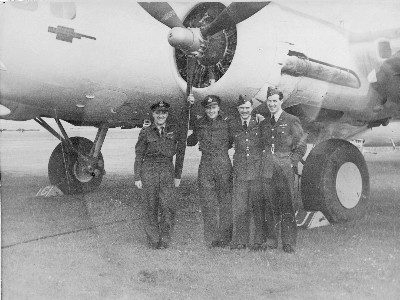
William Roxburgh
Rank: Flight Lieutenant
Number: 63802
Joined 206: ??/??/1941
Flew with Ken: 0 times
Born: 03/06/1912
Died: ??/09/1995
I have known about William Roxburgh for a number of years as his name came up in the very first Memoir I added to the site on Pilot John Owen. Here's the list of existing Memoirs where William is mentioned:
-
Pilots: Part I: John Owen
-
Wireless Op/Air Gunners: Part I: Richard Thomas
-
Wireless Op/Air Gunners: Part I: George Cairns
-
Wireless Op/Air Gunners: Part II: Bill Blackwell
Robert Stitt advised me that F/Lt William Roxburgh was generally known as 'Willis'. Roxburgh first sons were generally known as William and therefore 'Willis' was used to differentiate him from his father and grandfather. I was contacted by Simon Nelson in 2007 with the following photographs:
F/O William 'Willis' Roxburgh
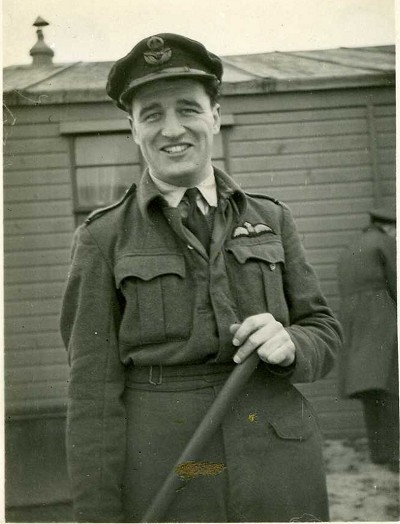
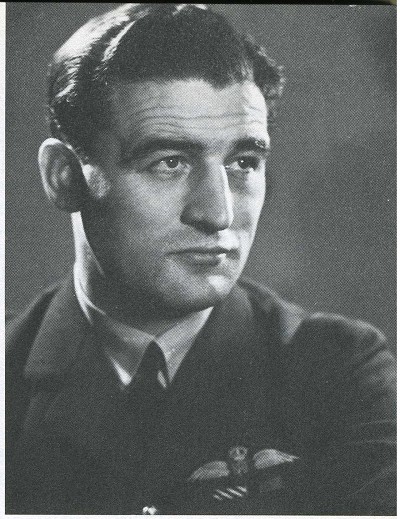
Margaret my Gran, always kept a look out in the Daily Telegraph for any links to Ken's time in WWII, on the 11th September 1995 she spotted this:
William Roxburgh's Obituary
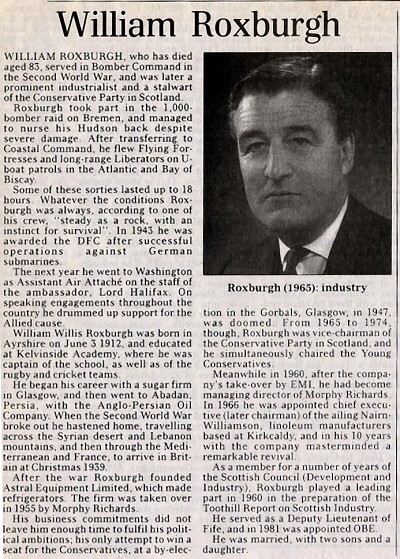
It was in 2009 and 2010 that I regularly corresponded with Richard Thomas who was part of William Roxburgh crew for a large period of WWII.
Richard Thomas has written a number of books, a number of which focused on his memories from WWII, reference to some of them can be found in the 'Useful Information' section.
As well as writing books, Richard also wrote articles for a local magazine. Some of these articles were written about his experiences and memories from his time in 206 Squadron and a number relate to times when William Roxburgh was the pilot. It is thanks to Richard that I'm able to create a Memoir for William Roxburgh.
Here are seven memories from Richard Thomas, all of which include the names of each crew member.
Thoughts Stirred By A Wartime Flyer's Logbook - 12/12/2007
25/6/42 23:20 Lockheed Hudson AM788 Pilot F/O Roxburgh
Night Bombing on Bremen - 6:00 hrs
Roxburgh - Owen - Thomas - Simpson
The return from the 1,000 bomber raid on Bremen had a special magic of its own. I remember sitting in the Boulton-Paul gun turret offering up a payer for a safe landing. Except for the throb of engines all was peaceful in sharp contrast to he hell that had broken loose over the target; flak from the ground defences hitting the aircraft early on, the thunder of noise from the attacking force of Lancasters, Whitleys and Hudsons, the hoarse cries over the intercom from fellow crew members, the rattle of machine gun fire against the fabric of our plane.
The sight of the English coastline brought a sigh of relief; relief that we had made it home in an aircraft shot from nose to tail and along both wings and with bomb doors still open unable to be closed. Landing safely at Donna Nook the verdict of the ground crew was that Hudson AM788 was unsafe to fly any further and we had to return to our main base at Aldergrove in another aircraft.
Thoughts that have lingered in my mind since that nightmare of a flight was whether it was worthwhile. The squadron lost three aircraft, with their crews, out of a total of twelve, having dropped 3,000 lbs of anti personnel bombs. A terrible price to pay for such a puny effect although the cumulative damage wrought by a thousand aircraft must have been devastating.
Some divine providence, no doubt, brought the crew of Hudson AM788 safely home that night. We put it down to flying in a lucky aircraft. Yet the aircraft that we looked upon as being lucky was eventually repaired and brought back into service only to crash n take off at Ras-el-Mar in Morocco on 25th July 1943 and was a complete write-off. Even the luck of such a sturdy plane ran out in the end.
8/2/43 14:25 Flying Fortress FL452 Pilot F/O Roxburgh
Convoy and Anti-Sub Patrol - 8:05 hrs
Roxburgh - Meech - Griffith - Thomas - Simpson - Eley - Churchill - Rimmer
The convoy was a splendid sight; some 40 to 50 merchant ships with an attendant escort of destroyers and corvettes headed by a battle cruiser. Nothing new in that. the crew aboard the Fortress had seen similar sights many times but not led by a cruiser flying the Stars and Stripes of the United States Navy. The pilot ordered me to make contact by use of Aldis lamp as radio silence was not to be broken. After countless circuits of the convoy I managed to flicker a Morse code word HUNGRY which was a shortened request to the Navy Commander from the International Code Book meaning HAVE YOU ANY INSTUCTIONS FOR US? When the answer came back it was not in code and took an interminable length of time to read, WE HAVE ICECREAM AND CAKE ABOARD IF YOU CAN GET IT.
As a crew we felt hugely irritated to say the least at what was obviously a total lack of comprehension on the part of the US Navy Commander; the retort from our pilot was unprintable. Looking back I can see the funny side of an exchange which had been totally lost in translation. Whatever career the Navy Commander may have had in the later part of the war he certainly had a sense of humour which surely must have carried him through the conflict. I smile now at the memory of the incident. There were some lighter moments even in Wartime.
More Memories From A Wartime Flyer's Logbook - 07/02/2008
27/3/42 08:25 Lockheed Hudson AM722 Pilot P/O Roxburgh
Anti-Sub sweep (Landed at Wick) 7:40 hrs
Roxburgh - Owen - Thomas - Simpson
Another uneventful operation searching for an elusive enemy. At least we might have kept a U-Boat underneath the waves rather than it sending valuable merchant ships and their crews to the bottom. Again we had been diverted owing to a complete blackout at base; low cloud, sweeping rain, visibility nil, this time to Wick.
Roxburgh brought the Hudson own and taxied to dispersal, opening the bomb doors to allow a squad of armourers to unload the four 250lb depth charges. An everyday routine, but not this time. A crash signalled that the depth charges had come loose from their fittings and landed on the tarmac, a thousand pounds of high explosive primed to detonate. The crew of AM722 were out of the plane and running for cover within seconds; the armourers already had a head start and were crouched behind the corner of the first building at hand.
A silence descended on the airfield as we waited. The our depth charges were sitting on the hard-standing looking like a set of oil drums. As the seconds ticked away it became clear that they were not going to explode. Tentatively, the F/Sgt i/c ground crew led his men back to the aircraft and they then proceeded to load up the depth charges on to a trailer and took the way.
My opposite number, Ray Simpson, made a remark which has lived in my memory,
"Somebody up there is trying to tell us something; maybe that we are doing too much of this operational flying"
That was in March 1942. We were still flying on operations in August 1943 when Admiral Doenitz had finally to admit that he Germans had lost the Battle of the Atlantic.
25/3/43 04:45 Flying Fortress FK195 Pilot F/O Roxburgh
Anti-Sub patrol (U-Boat sighted and attacked) 11:10 hrs
Roxburgh - Meech - Griffith - Thomas - Simpson - Eley - Churchill - Rimmer
It had been a patient approach. Ten miles, above cloud, the sweeping line on the radar screen showing a small blob getting larger with every minute. I had guided the pilot on t what we thought would be a small boat fishing out from Iceland. When we broke cloud cover there it was - a U-boat sitting on the surface, conning tower hatch open, three men on top breathing in fresh air. Everyone was taken by surprise; the U-boat captain, the men on the conning tower, the aircrew, and probably most of all F/O Roxburgh. As he himself described it he had to virtually stand the big, four engined Fortress on its nose and use it as a dive bomber aiming straight for the U-boat. The commander of the vessel was taking it down to hoped-for safety. I can still recall the first casualties of the conflict; the three German sailors who were thrown into the sea as their boat began to disappear below the waves.
The six 250lb depth charges fell in a perfect straddle, three on either side of the U-boat. Seconds later a huge spout of water rose into the air as the charges exploded. It was later that we learned that the attack was assessed as a "kill". In the minds of the crew of FK195 there was no doubt; the angle of descent, the floating debris, the oil slick, told their own story. The euphoria in the aircraft knew no bound. We had succeeded in sinking one of the marauders of the shipping lanes, had carried out the job for which we had been trained, and for which we eventually received thanks and commendation from higher command. Yet, looking back, I have a felling of regret.
Regret the war should make it necessary for young men to be trained to kill, or maim, others in any way possible. So little has been learned by governments and people in authority in the last 60 years or so. As Pete Seager put in to words in his Ballard,
Where have all the flowers gone:
When will they ever learn?
When will they ever learn?
Fortress FA709 'B'
WOp/AG Jock Rimmer - Navigator F/Sgt Joe Griffith - WOp/AG Richard Thomas
Pilot 'Willis' Roxburgh - WOp/AG Sgt Ray Simpson - Co-Pilot Sgt Lloyd Meech
WOp/AG F/Sgt Douglas Eley - Sgt Jack Churchill

It's worth noting that although William Roxburgh's crew are standing in front of Fortress FA709 'B', the aircraft was actually one of 220 Squadron opposed to 206 Squadron.
Final Thoughts From A Wartime Flyer's Logbook - 07/04/2008
15/12/42 09:55 Flying Fortress FK213 Pilot F/O Roxburgh
Air Sea Rescue Search for A/C 'A' 206 (F/O Owen and Crew) Nothing seen - 8:45 hrs
Roxburgh - Lovell - Griffith - Thomas - Simpson - Eley - Churchill - Rimmer
At the moment that news filtered through that F/O Owen and his crew were long overdue Ray Simpson and I made our way to the Operations Room at Benbecula. F/O Roxburgh was already there. John Owen had been our constant companion on many a Hudson sortie before forming his own Fortress crew. After much pressure on the Station Commander and Group HQ it was agreed that one aircraft would be allowed to make a search for our missing comrades.
We took off at 9:55 on 15th December, flying out across the heaving waters of the Atlantic, every eye on the look-out for the sighting of a dinghy. Like ourselves, Owen's aircraft would have a crew of eight. Even, if by some miracle, they had been able to climb out of a ditched aircraft it was doubtful if they could have survived the ordeal of wind and rain, and a stormy sea that only the North Atlantic can produce.
I felt a shiver run through me as I sat in the tail turret, a shiver of apprehension as much as from the cold. All I could see in my mind's eye was an image of John Owen's bright face, blue eyes twinkling as he asked if he could borrow a book from me, Howards Spring's Fame is the Spur. He had been attracted by a quotation used by the author in the preface, a few lines from Milton's Lycidas:
Fame is the spur that the clear spirit doth raise
That last infirmity of noble mind
To scorn delights and live laborious days.
For John Owen and his men there was to be no future fame. We searched to the limit of our endurance then returned to base a saddened and dispirited crew. I fell asleep that night to the sound of music floating on the wind outside the airfield paying a tribute to the Squadron's loss in the way that only the local people knew, a Scottish lament. A tune that brought a tear to the eye of an erstwhile comrade.
29/7/43 04:55 Liberator FL916 Pilot F/Lt Roxburgh
Escort to the Queen Mary - 16.15 hrs
Roxburgh - Meech - Griffith - Thomas - Simpson - Eley - Churchill - Rimmer
It was a strange night. A lone ship making its way west across the Atlantic; no convoy with its attendant destroyers and corvettes, nothing but the vast expanse of ocean stretching from horizon to horizon. The ship was ordinary one; it was the Queen Mary, the pride of the pre-war passenger service to America. Because its speed was too great to be held back by the slowest ship in a convoy it was programmed to sail unescorted except for air-cover. Its safe passage was probably helped by the fact that the Battle of the Atlantic had been virtually won. The wolf packs of U-boats, over a hundred at any one time, had been drawn back to their bases.
We flew round the ship for several hours keeping a look-out for any lone U-boat attacker but none was to be seen. When a speck in the sky from the west materialised into a relief Liberator out from Canada we dipped our wings in a farewell salute and headed back home. I did not know then that I would soon be sailing the high seas in a similar vessel, the Maurentania, en route for Halifax, Nova Scotia, thence down the Eastern seaboard of America to Boston, New York, Florida and, finally, to the Bahamas.
4/8/43 12:30 Liberator FL932 Pilot F/Lt Roxburgh
Convoy and Anti Sub patrol - 14:45 hrs
Roxburgh - Meech - Griffith - Thomas - Simpson - Eley - Churchill - Rimmer
Our final flight.
We had been informed at the briefing that this was to be our last foray over the Atlantic having, in my case, reached a total of 1221 hours; a double tour of ops. In the event it was as uneventful as our first flight as a crew in November 1941. It did, though, give me time to reflect on some of the events which had taken place in almost 2 years; countless hours flying over what seemed to be an endless ocean; the odd sighting of a U-boat; the emergency landings at Castletown and Wick; the 1,000 bomber raid on Bremen; the sinking of U-boat 469; and any number of other incidents. What among those moments of stress and danger was the thing which caused me the most anxiety? It had to be spending an hour in the ball turret of a Flying Fortress - not once, but twice, in a flight of normal duration. I can feel the trickle of ice run down my spine now at the thought of it; the memory of that seemingly endless hour attached to the belly of the aircraft yet not feeling part of it; rotating the turret through 360 degrees; firing a test burst with the twin 0.5 Browning machine guns and feeling the sting of the cordite fumes in one's nostrils; the relief when a rap on the metal of the turret indicated that you were about to be released from a claustrophobic hell. There were 5 Wireless Operator/Air Gunners in the Fortress crew but I never heard one of them say that they enjoyed the experience.
Some of the crew were rewarded for their efforts by being sent to the Bahamas to teach others all they knew about operational flying. There were eight of us who parted company at that time; men who had flown on Hudsons, Fortresses and Liberators; men who had braved various dangers together under the safe hands and leadership of our pilot, Willis Roxburgh; men who never gave a thought to the idea that they were doing anything out of the ordinary. As the last surviving member of this band of brothers how should I end this series of reminiscences of my Wartime flying? Shortly after the War I bought a booklet written by Anthony Armstrong, the title of which aptly sums up my present feelings, GOODBYE, NICE TYPES.
Thank you to Richard Thomas for this wealth of information
Robert Stitt explained that William Roxburgh moved from 206 Squadron to 86 Squadron on the 4th of April 1943, where they had re-equipped with Liberators. He also provided the following information on William Roxburgh's DFC that was awarded on the 9th July 1943.
DFC citation
"Since joining this Squadron in September 1943, this officer has operated continuously with great success. He has made several effective attacks on U-boats in the Atlantic and took part in the "1,000 bomber" raid on Bremen. On that occasion, his aircraft was severely damaged by anti-aircraft fire on the way to the target. A petrol tank was holed and instruments put out of action. This did not however, deter Flight Lieutenant Roxburgh from bombing the target successfully and flying his aircraft safely to base. Throughout all these missions, this officer has displayed ability, enthusiasm and devotion to duty."
Links to Ken
Ken had several superiors through his time in the 206 Squadron, one of these was William Roxburgh. He was Ken's Flight Officer in August and September in 1942 and he signed off the summaries in Ken's Log-book for those months, here's September 1942:
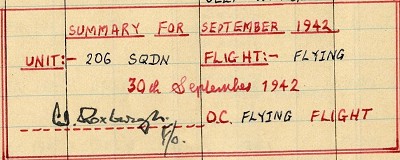
William Roxburgh also took part in the same 1,000 Bomber Raid as Ken in June 1942, the newspaper obituary and one of Richard Thomas' stories details the fact that his Hudson suffered severe damage during the raid but he managed to nurse it back home.
Courtesy of Robert Stitt I originally found out that William Roxburgh and his crew sank a U-Boat (U-469) on the 25th March 1943. The aircraft used was Flying Fortress FK195 'L', this exact aircraft was piloted by Ken on 4 separate occasions (November 1942 to February 1943) before the U-Boat sinking.
Just 2 days later F/O Ian Samuel and crew went on to sink another U-Boat (U-169) using the same aircraft. On cross referencing Ken's Logbook, he's also recorded as flying with F/O Samuel on 7 separate occasions; 3 times in 1942 and 4 times in February 1943 - the month before the U-Boat sinkings.
Anthony F George
Rank: Pilot Officer Number: 87392 Joined 206: ??/??/194? Flew with Ken: 0 times Born: ??/??/1916 Died: 13/06/1941
In October 2010 I received a message on the 'Guest Book' about Anthony Frederick George, it had been written by Richard Crockett who is first cousin once removed to Anthony.
Richard explained he remembers meeting Anthony just the once when he was a small child. He remembers a tall figure in uniform at a time which must have been just weeks or days before he went missing on the 13/06/1941. At the time Richard and his family were based in Cobham having moved from Hereford due to the recent major bombing raid on London on the 10/05/1941. Richard remembers his mother having to trek across London to recover furniture from their house in Enfield after that raid.
On checking the 'Roll Of Honour' page I established that Anthony was part of a 4 man crew that failed to return on the 13/06/1941, this would make them a Lockheed Hudson crew. The 4 men mentioned are as follows:
- P/O A.F George (87392) Pilot
- P/O S.H Dale (87431) Navigator
- Sgt E Johns (751751)
- Sgt R.D Mills (751580)
Anthony was 24 at the time the crew failed to return. After checking through the 206 Squadron Official Archives I found reference to the operation below.
206 Squadron Official Archive
13/06/1941


We know that they took off at 04.40 on the 13/06/1941 from Bircham Newton, they were flying in Hudson AE612 'O' and they were sent out to search for another Hudson that had gone missing the day before. That aircraft was Hudson AE614 'J' who on the 12/06/1941 were searching for a dinghy from a downed Wellington, that Hudson crew comprised of:
- P/O Sharp
- P/O Gordon
- Sgt Bissen
- Sgt Oxley
There is mention of these 2 incidents in Peter Gunn's book 'Naught Escape Us' which states it was likely that both Hudson's were shot down by enemy fighters.
Nicodeme Guilonard
Rank: Lieutenant Commander
Number: 147167
Joined 206: ??/01/1945
Flew with Ken: 0 times
Born: 29/06/1904
Died: 21/04/1945
Links to other Memoirs
-
George Topliff: 'Navigators: Part II' section
I was contacted in November 2010 by Niels Norgaard Nielsen who was researching a Liberator crash in Denmark. It turned out that the pilot of that Liberator was Nicodeme Guilonard who was part of 206 Squadron.
Nicodeme Guilonard
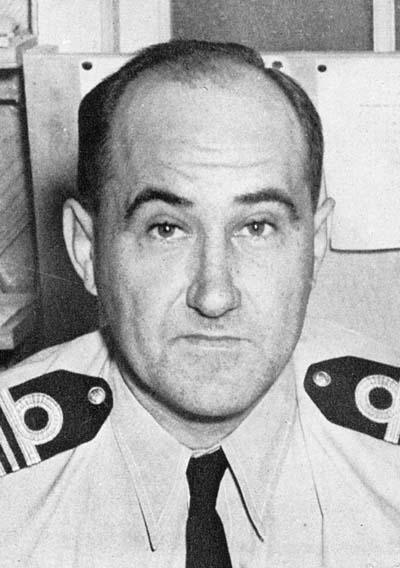
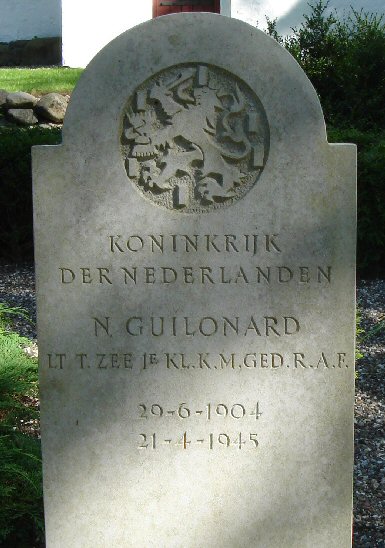
Niels had obtained some information written by Nicodeme's wife Wilhelmina Guilonard. In summary he was born in Brielle in the Netherlands. He was originally a sailor with the Royal Netherlands Navy and joined the Royal Air Force when the Dutch Air Force was destroyed at the start of the war. In December 1943 he went to Canada to learn to fly the Liberator B24. In March 1944 he came over to the UK and joined 206 Squadron in January 1945 based in Leuchars.
Liberator Mk VIII KH410
20/04/1945
On the 20/04/1945 two Liberator crews had taken off from Leuchars around 8pm, one of those was captained by Guilonard and the other by F/O Elviss. F/O Eliviss' crew had spotted a U-Boat and attacked it, returning to base at 6:18am on the 21/04. Guilonard's crew were not so lucky, they failed to return and were posted as missing. It's was originally thought they were shot down by AA fire or enemy fighters, however a websites write up (airmen.dk - link at the bottom of this memoir) advises us that there were no reports of AA fire or claims from German fighters. We can therefore conclude that the Liberator may have crashed into one or more of the forest trees which was a similar fate for a Mosquito.
Guilonard's Liberator crew comprised of the following on that operation:
-
Lt Cmdr N Guilonard (147167) Pilot
-
F/O A.R.T Smith (NZ 4214135) 2nd Pilot
-
P/O G.H Topliff (Aus 419396) Navigator
-
F/O A.J Harding (153317) Navigator
-
F/O W.T.H Gale (190271) Flight Engineer
-
W/O G.C.K Long (1319712) AG
-
W/O W.W Spencer (R 110774) WOp/AG
-
W/O T.K Theaker (R 132255) AG
-
W/O K Emery (1076591) AG
-
F/S F.R Orritt (1432826) WOp Mechanic
Here are a number of photographs of Guilonard's Liberator crew that were supplied by Ann Jordan who is the daughter of one of the crew: Kenneth Emery.
Guilonard's Liberator Crew
Laycock - Topliff - Long - Guilonard - Harding - Smith - Spencer
Theaker - Orritt - Emery - Gale
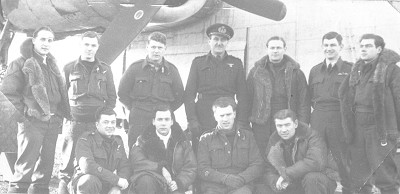
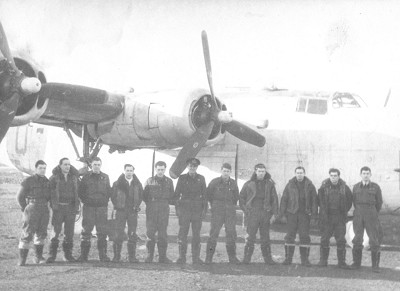
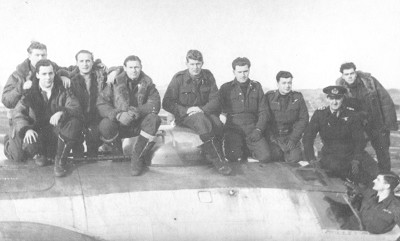
Niels supplied the following information and photographs which are also hosted on 2 other websites listed at the bottom of this memoir.
The Liberator crashed at Torstedlund Skov Forest south of Aalborg around midnight. It left a trail of destruction in the forest as seen here.


You can read an account by Peter Hansen who was nearby at the time of the crash. It was translated by Anders Straarup.
Peter Hansen's Account
Around 7:20pm on the 21st April the crew were buried by the Germans in a shallow grave about 30 meters north of the crash site.
On the 04/08/1945 a memorial was constructed using a local stone and some of the wreckage by the labourers at the Norlund sawmill.
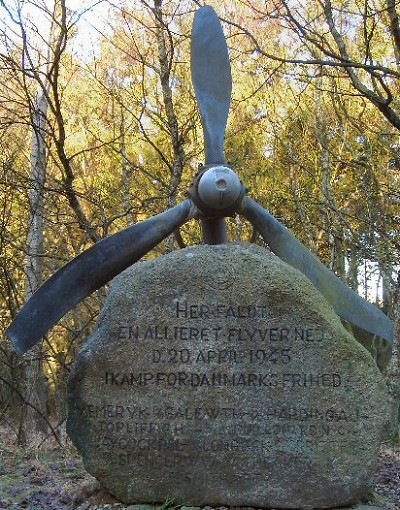
It wasn't until the 14/06/1947 that the grave was found and the bodies were placed in coffins, they were taken to Aarestrup cemetery chapel on the 19/06 and on the 22/06 at 4pm the crew were laid to rest.
The ceremony took place in the presence of several British and Danish dignitaries. In the 2nd photograph below, Wilhelmina Guilonard is to the left of the flag, the man with the black hat is Cantor Theodor Johansen who wrote a diary capturing many interesting facts about the crash, and the priest is Harald Davidsen.
